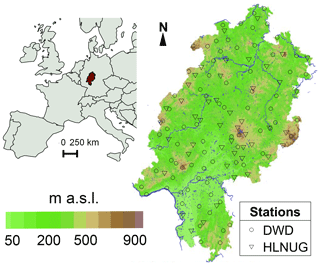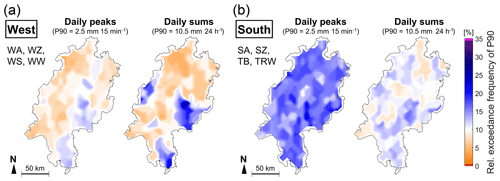Statistical analysis of very high-resolution precipitation data and relation to atmospheric circulation in Central Germany
The cumulative occurrence of heavy precipitation and flood events during recent years in various Central European locations emphasises the urgent need to improve extreme rainfall observations and forecasts. Precipitation gauges based on a weighing system allow the recording of intense short-term precipitation events with a very high temporal resolution (down to 1 min). In this study, observational data that were collected during the period 2000 to 2016 for 126 stations of two corresponding measuring networks in the Central German state of Hesse were investigated for the first time to answer the following questions: (1) Are the recorded high-resolution precipitation data plausible and comparable between both networks? (2) Which atmospheric circulation patterns were specifically prone to produce short-term intense precipitation events?
Although the two networks are equipped with the same measuring technology, systematic differences concerning their maximum 1 min precipitation amounts occur, which may be explained by different instrumental software settings. We could minimise those discrepancies by accumulating the existing 1 min data to 15 min.
Subsequently, the 15 min daily maximum values and accumulated daily sums were analysed regarding the impact of large-scale atmospheric circulation patterns, based on the well-known “Großwetterlagen” classification. We identified a clear connection between atmospheric circulation and heavy precipitation over Hesse, while indicating some differences between daily (24 h) and sub-daily (15 min) events. High daily precipitation sums often relate to westerlies and central cyclones, while intense short-term events are frequently generated by warm-humid continental air from southern and eastern Europe as well as trough conditions, where the trough's core is found west of the study area. Our results underline the importance of expanding and enhancing high-resolution precipitation observations in Germany as well as other countries.









